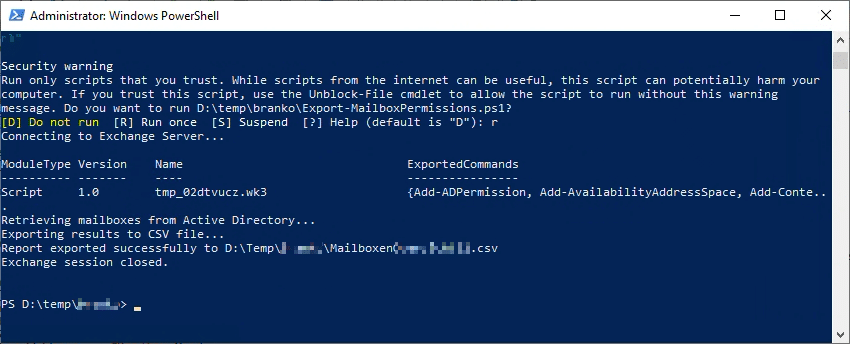In many organizations, shared mailboxes are a critical component for collaborative work. They allow multiple users to access and manage a common mailbox, enabling seamless communication within teams. However, monitoring mobile access to these shared mailboxes can be a challenge, especially when it comes to ensuring security and compliance.
ActiveSync, Microsoft’s synchronization protocol, allows mobile devices to access Exchange mailboxes. While this is convenient, unauthorized or unmanaged mobile access to shared mailboxes can pose security risks. Therefore, it’s essential to have visibility into which shared mailboxes have ActiveSync enabled and which mobile devices are accessing them.
To address this need, I developed a PowerShell script that generates detailed reports on shared mailboxes and their associated mobile devices in an Exchange Server 2019 environment.
Table of Contents
The Solution
The script performs the following actions:
- Retrieves all shared mailboxes in the Exchange environment.
- Checks if ActiveSync is enabled for each mailbox.
- Identifies any mobile devices accessing these mailboxes.
- Gathers detailed statistics for each device.
- Exports the information into two separate CSV files:
- SharedMailboxesReport.csv: Contains mailbox-level information.
- MobileDevicesReport.csv: Contains device-level information with references to their associated mailboxes.
By using this script, administrators can easily monitor mobile access to shared mailboxes and take appropriate action if necessary.
Script Overview
Get-SharedMailboxesMobileAccessReport.ps1
<#
.SYNOPSIS
Exchange Server 2019 Shared Mailboxes Mobile Access Report
.DESCRIPTION
This PowerShell script retrieves all shared mailboxes in an Exchange Server 2019 environment, checks if ActiveSync is enabled for each mailbox, identifies any mobile devices accessing them, gathers detailed statistics for each device, and exports the information into two separate CSV files:
1. SharedMailboxesReport.csv - Contains mailbox-level information.
2. MobileDevicesReport.csv - Contains device-level information with references to their associated mailboxes.
.PREREQUISITES
- Exchange Server 2019
- Administrative permissions to execute Exchange cmdlets
- Exchange Management Shell or imported Exchange module in PowerShell
- PowerShell 5.1 or later
.USAGE
1. Open the Exchange Management Shell with administrative privileges.
2. Copy and paste the script into the shell or save it as `Get-SharedMailboxesMobileAccessReport.ps1` and execute it by navigating to its directory and running:
.\Get-SharedMailboxesMobileAccessReport.ps1
3. The reports will be generated at the specified export paths:
- SharedMailboxesReport.csv
- MobileDevicesReport.csv
.OUTPUTS
- CSV files containing detailed reports on shared mailboxes and their associated mobile devices.
.EXAMPLE
.\Get-SharedMailboxesMobileAccessReport.ps1
.NOTES
- Ensure that the executing account has the necessary permissions for both `Get-MobileDevice` and `Get-MobileDeviceStatistics` cmdlets.
- Modify the `$mailboxesExportPath` and `$devicesExportPath` variables as needed to specify different export locations.
#>
# Exchange Server 2019 PowerShell Script
# Description: Retrieves shared mailboxes, checks if ActiveSync is enabled,
# identifies mobile devices accessing them, retrieves detailed statistics,
# and exports the information to separate CSV files for mailboxes and devices.
# Define the output CSV file paths
$mailboxesExportPath = "C:\Reports\SharedMailboxesReport.csv"
$devicesExportPath = "C:\Reports\MobileDevicesReport.csv"
# Ensure the export directory exists; create it if it doesn't
$exportDirectory = Split-Path -Path $mailboxesExportPath
if (!(Test-Path -Path $exportDirectory)) {
New-Item -Path $exportDirectory -ItemType Directory -Force | Out-Null
}
# Retrieve all shared mailboxes
$sharedMailboxes = Get-Mailbox -RecipientTypeDetails SharedMailbox -ResultSize Unlimited
# Initialize arrays to store the report data
$mailboxesReport = @()
$devicesReport = @()
# Iterate through each shared mailbox
foreach ($mailbox in $sharedMailboxes) {
try {
# Get Client Access settings for the mailbox
$casMailbox = Get-CASMailbox -Identity $mailbox.Identity
# Check if ActiveSync is enabled
$activeSyncEnabled = $casMailbox.ActiveSyncEnabled
# Initialize variables for mobile device information
$mobileDeviceCount = 0
if ($activeSyncEnabled) {
try {
# Retrieve mobile devices associated with the mailbox
$mobileDevices = Get-MobileDevice -Mailbox $mailbox.Identity -ErrorAction Stop
if ($mobileDevices) {
$mobileDeviceCount = $mobileDevices.Count
foreach ($device in $mobileDevices) {
try {
# Retrieve statistics for each mobile device
$deviceStats = Get-MobileDeviceStatistics -Identity $device.Identity -ErrorAction Stop
# Create a custom object with desired properties
$deviceDetail = [PSCustomObject]@{
MailboxName = $mailbox.DisplayName
MailboxIdentity = $mailbox.Identity
DeviceName = $device.DeviceName
DeviceType = $device.DeviceType
DeviceOS = $device.DeviceOS
LastSuccessSync = $deviceStats.LastSuccessSync
LastSyncAttemptTime = $deviceStats.LastSyncAttemptTime
LastPolicyUpdate = $deviceStats.LastPolicyUpdate
LastAccessTime = $deviceStats.LastAccessTime
DeviceUserAgent = $deviceStats.UserAgent
DeviceAccessState = $deviceStats.DeviceAccessState
DeviceAccessStateReason = $deviceStats.DeviceAccessStateReason
}
# Add the device detail to the devices report array
$devicesReport += $deviceDetail
}
catch {
# Handle errors when retrieving device statistics
$deviceDetail = [PSCustomObject]@{
MailboxName = $mailbox.DisplayName
MailboxIdentity = $mailbox.Identity
DeviceName = $device.DeviceName
DeviceType = $device.DeviceType
DeviceOS = $device.DeviceOS
LastSuccessSync = "Error: $_"
LastSyncAttemptTime = "Error: $_"
LastPolicyUpdate = "Error: $_"
LastAccessTime = "Error: $_"
DeviceUserAgent = "Error: $_"
DeviceAccessState = "Error: $_"
DeviceAccessStateReason = "Error: $_"
}
$devicesReport += $deviceDetail
}
}
}
}
catch {
# Handle cases where Get-MobileDevice might fail
Write-Warning "Error retrieving mobile devices for mailbox '$($mailbox.Identity)': $_"
}
}
# Create a custom object with the desired mailbox properties
$mailboxReportObject = [PSCustomObject]@{
MailboxName = $mailbox.DisplayName
MailboxIdentity = $mailbox.Identity
ActiveSyncEnabled = $activeSyncEnabled
MobileDeviceCount = $mobileDeviceCount
}
# Add the mailbox object to the mailboxes report array
$mailboxesReport += $mailboxReportObject
}
catch {
# Handle any errors encountered while processing the mailbox
Write-Warning "Failed to process mailbox '$($mailbox.Identity)': $_"
}
}
# Export the mailboxes report to a CSV file
try {
$mailboxesReport | Export-Csv -Path $mailboxesExportPath -NoTypeInformation -Encoding UTF8
Write-Output "Mailboxes report successfully exported to '$mailboxesExportPath'."
}
catch {
Write-Error "Failed to export mailboxes report to CSV: $_"
}
# Export the devices report to a CSV file
try {
$devicesReport | Export-Csv -Path $devicesExportPath -NoTypeInformation -Encoding UTF8
Write-Output "Mobile devices report successfully exported to '$devicesExportPath'."
}
catch {
Write-Error "Failed to export mobile devices report to CSV: $_"
}
Script Breakdown
- Retrieving Shared Mailboxes: The script uses
Get-Mailboxwith the-RecipientTypeDetails SharedMailboxparameter to retrieve all shared mailboxes in the environment. - Checking ActiveSync Status: For each mailbox, it retrieves the Client Access settings using
Get-CASMailboxand checks if ActiveSync is enabled. - Identifying Mobile Devices: If ActiveSync is enabled, the script uses
Get-MobileDeviceto retrieve all mobile devices associated with the mailbox. - Gathering Device Statistics: It then gathers detailed statistics for each device using
Get-MobileDeviceStatistics. - Error Handling: The script includes comprehensive error handling to manage any issues that arise during execution, such as permissions errors or devices that cannot be queried.
- Exporting Reports: Finally, it exports the gathered data into two CSV files for further analysis.
How to Use the Script
Prerequisites
- Exchange Server 2019: The script is designed for Exchange Server 2019 environments.
- Administrative Permissions: You need permissions to execute Exchange cmdlets, particularly
Get-MobileDeviceandGet-MobileDeviceStatistics. - Exchange Management Shell: Run the script in the Exchange Management Shell or ensure the Exchange module is imported into PowerShell.
- PowerShell 5.1 or Later: The script requires PowerShell 5.1 or later.
Steps
- Download the Script: Download the script from the GitHub repository or copy the code provided above.
- Modify Export Paths (Optional): By default, the script exports the reports to
C:\Reports\SharedMailboxesReport.csvandC:\Reports\MobileDevicesReport.csv. You can modify the$mailboxesExportPathand$devicesExportPathvariables in the script to change the export locations. - Run the Script:
- Open the Exchange Management Shell with administrative privileges.
- Navigate to the directory containing the script.
- Execute the script:
.\Get-SharedMailboxesMobileAccessReport.ps1
- Review the Reports:
- SharedMailboxesReport.csv: Contains information about each shared mailbox, including whether ActiveSync is enabled and the number of mobile devices associated.
- MobileDevicesReport.csv: Provides detailed information about each mobile device accessing the shared mailboxes.
Security Considerations
- Permissions: Ensure the account running the script has the necessary permissions to execute all required cmdlets.
- Data Handling: The generated CSV files contain sensitive information. Store them securely and restrict access as needed.
- Compliance: Verify that collecting and storing this data complies with your organization’s policies and any applicable regulations.
Conclusion
Monitoring mobile access to shared mailboxes is vital for maintaining the security and integrity of your organization’s communication systems. This script provides a straightforward way to generate detailed reports, enabling administrators to:
- Identify shared mailboxes with ActiveSync enabled.
- Discover all mobile devices accessing these mailboxes.
- Review device-specific information, such as last sync times and device types.
By regularly running this script and reviewing the reports, you can ensure that mobile access to shared mailboxes is appropriately managed and secure.
Additional Resources
- GitHub Repository: virtualox/Get-SharedMailboxesMobileAccessReport.ps1
- Exchange Server Cmdlets:



